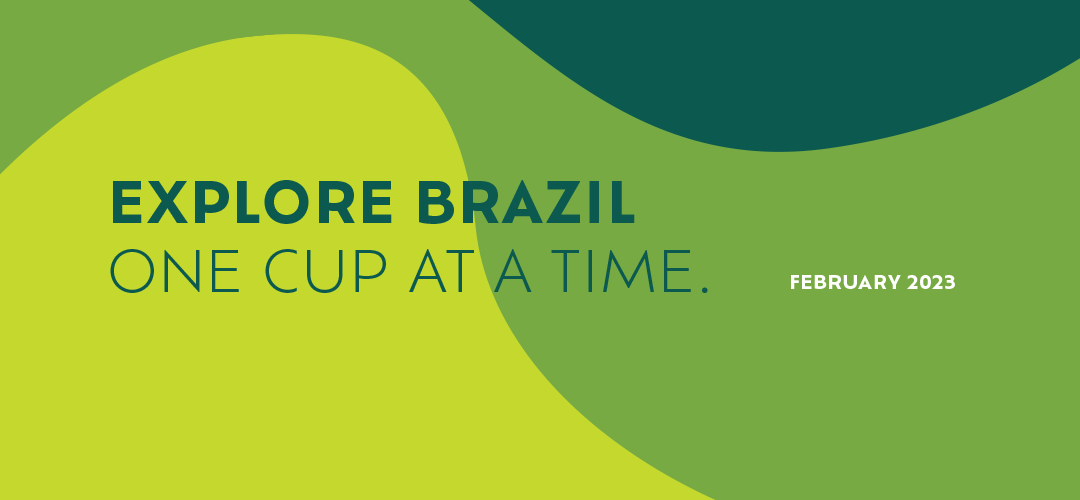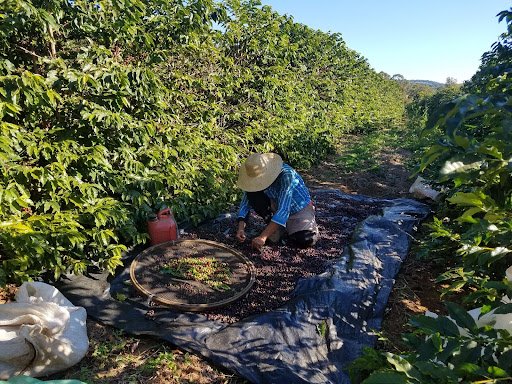Explore Brazil: February 2023
This month we Explore Brazil with our Samba Blend, the Mantiqueira de Minas region, and our partner Ademilson Noiman and his farm, Sítio Grota Fria.
Brazilian Blend: Samba
It’s February, and that can only mean one thing in Brazil: Carnaval! As a tribute to Carnaval, this month’s featured coffee is our Samba blend. Although “samba” often conjures up images of scantily clad, gyrating Brazilian women—and there definitely is a lot of that at Carnaval—the history and complexity of the music are much deeper.
Much like American blues, samba took root in rural dance music created by African descendants, then made its way to the larger cities, principally Rio de Janeiro, through the urbanization that occurred in the early part of the last century. From there, the genre continued to develop, taking influence from its urban environment. Samba Schools such as Mangueira and Portela formed. Every year at Carnaval, the schools—dancing, marching, and drumming clubs built around their namesake music—present allegorical stories through their floats, costumes, samba enredos (a type of samba where the songs recount stories), and, yes, the gyrating dancers.
Again, just like American blues, samba has spawned myriad musical genres in Brazil, from bossa nova to pagode to the various forms of Musica Popular Brasileiro (MPB) found today. We asked Mike Quinn, a samba enthusiast, musician, music critic, and samba master at Austin’s famed Carnaval Brasileiro to design our Spotify playlist this month.
Casa Brasil’s Samba Blend is a tribute to samba music and traditions. Like our Bossa blend, it is designed to bring out the best of Brazilian coffee. Where Bossa blend is lighter, with notes of caramel, citric brightness, nuttiness, and hints of fruit, Samba blend brings notes of dark chocolate and rich caramel with hints of malt and almonds.
Regional Blend: Mantiqueira de Minas
The Mantiqueira de Minas region is a subregion of the Sul de Minas coffee macro-region. It has long been known for producing high-quality coffees, as a 1904 excerpt from Maine’s Republican Journal attests after the writer’s trip to Brazil. “After leaving Resende we pass along the rim of an enormous valley, bordered by the coast range on one hand and the Sierra do Mantiqueira [sic] on the other. In the latter range, the splendid peak "Itatiaia" (the highest in Brzail [sic], about 9,000 feet) is in full view, and immediately west of the mountains are the most famous coffee regions in the world.”
The origin of the region’s name explains one of the reasons behind this quality. In the Tupi-Guarani language spoken by the natives of the region, Mantiqueira means “Crying mountain.” The Serra da Mantiqueira is known for its plentiful rainfall as well as its natural springs, and many bottled water brands are from here.
Along with abundant rainfall, the region also benefits from higher altitudes, cooler temperatures, and fertile soils. Several multi-year studies have documented the unique terroir of the region and shown how these factors correlate to coffee quality.
These studies supported the region’s application for a Denomination of Origin (DO)—a distinction for a geographical area whose distinct geography and/or traditions lead to the production of a unique product. The DO was granted in 2020. A map of the region can be found below
Microlot: Ademilson Noiman
Ademilson Noiman at his farm Sítio Grota Fria
In fact, it was my participation in several of these studies that led to our partnership with APAS—the Associação dos Produtores do Alto da Serra (Association of Producers from the High Hills), a Fair Trade–certified association of over 40 coffee-growing families—and APAS member Ademilson Noiman.
I was part of the team that performed the quality analysis in several of these studies through my relationship with the Universidade Federal de Lavras (where I would later pursue a master's degree in post-harvest processing). As the data came in, it became clear that within the “privileged” Mantiqueira de Minas region, certain microclimates were consistently producing better coffees. One of them was located around APAS.
I visited APAS, and Casa Brasil started regularly buying coffee from APAS members. Ademilson, along with Augusto Borges and Alessandro Hervaz, was one of the members who consistently had some of the best coffees.
Meeting with APAS members early on in our partnership.
After several years and many discussions about how we could improve the quality of what we were doing all the way to the cup, we decided to introduce the “Selective Harvest Project.” Historically, Brazil has relied on the strip-harvesting of all fruit maturations at once. Though today this is due to high labor costs and a lack of available rural labor, it was also the dominant harvest method even in times of slavery. The problem today is that the cost of harvesting the coffee using a manual selective harvest (where only ripe fruit is picked) is often higher than the price of the coffee itself. And that is if the labor is even available. Picking coffee is low-paying, arduous work, and when given the opportunity to do something else, people will tend to opt for that something else. For the project, Casa Brasil Coffees guaranteed a high price that would ensure a profit above the increased labor costs and allow for attracting high-quality pickers with a substantially higher rate. The result was a win-win across the supply chain. Coffee pickers received more money for their efforts, our partners at APAS received more money for their coffee, and we (Casa Brasil and, yes, you, dear reader 🙂) got some incredible coffee that did not exist before and would not have existed otherwise. For his efforts, Ademilson won the Fair Trade competition in Brazil with his selectively-harvested coffee.
Hand-sorting of the coffee for the selective harvest project.








